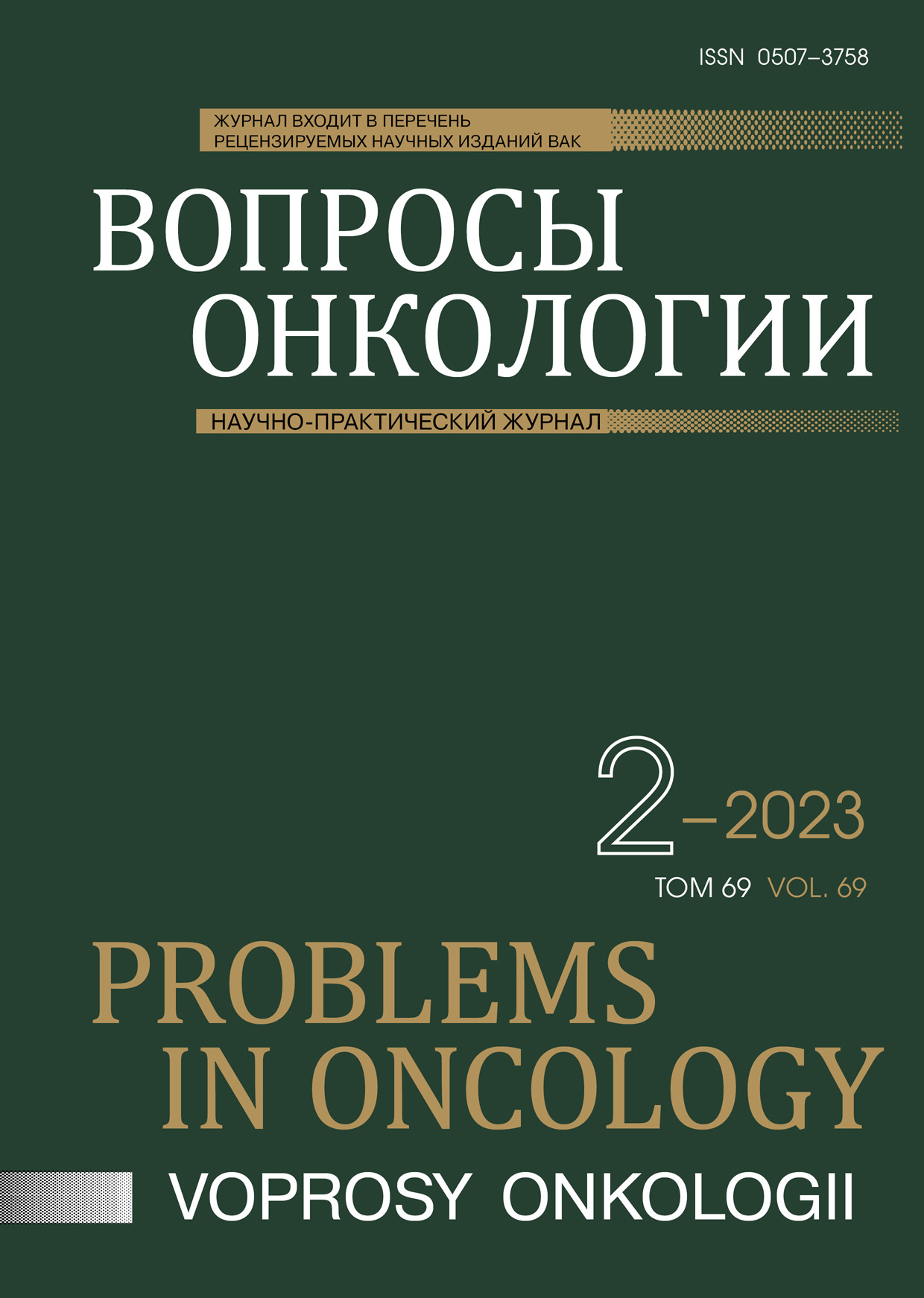摘要
Литературный обзор описывает значение сосудистых механизмов в реализации радиобиологических эффектов высокодозной лучевой терапии. Основные понятия радиобиологии можно свести к нескольким тесно взаимосвязанным моделям: линейно-квадратичной, сосудистой, иммунной и немишенной. Каждая из них описывает свое звено совокупного ответа на проводимое облучение, а их роль и вклад меняются в зависимости, прежде всего от разовых доз, а затем от режимов фракционирования и общих доз. Накопленные данные свидетельствуют о целесообразности формирования единой обобщающей модели.
Сосудистая сеть имеет важное значение в пролиферации и выживании опухолевых клеток, во многом определяя условия микросреды и общий ответ на лучевую терапию. Высокие дозы облучения за фракцию (более 10Гр) приводят к сосудисто-эндотелиальному апоптозу, немедленной тяжелой сосудистой реакции и глубокой ишемии опухоли. Этот феномен связан с активацией кислой сфингомиелиназы, последующим гидролизом сфингомиелина, генерирующего церамид, индуцирующий трансмембранный сигнал апоптоза.
参考
Qiu B, Aili A, Xue L. et al. Advances in radiobiology of stereotactic ablative radiotherapy. Front Oncol. 2020;7(10):1165. doi:10.3389/fonc.2020.01165.
Vaughan A, Rao SD. Radiobiology of stereotactic radiosurgery and stereotactic body radiotherapy. In: Sethi RA, Barani, IJ, Larson DA, Roach III M, editors. Handbook of Evidence-Based Stereotactic Radiosurgery and Stereotactic Body Radiotherapy. Cham (Switzerland): Springer. 2016:11-19. doi:10.1007/978-3-319-21897-7.
Beyzadeoglu M, Ozyigit G, Ebruli C. Basic Radiation Oncology. Berlin: Springer; 2010: 575. doi:10.1007/978-3-642-11666-7.
Joiner MC, van der Kogel AJ. et al. Basic Clinical Radiobiology. 5th ed. CRC Press, Taylor and Francis Group. 2018; 360. Available from: https://doi.org/10.1201/9780429490606.
Trifiletti DM, Chao ST, Sahgal A. et al. Stereotactic radiosurgery and stereotactic body radiation therapy. Switzerland AG: Springer Nature; 2019: 435. doi:10.1007/978-3-030-16924-4.
Zeman EM. The history and radiobiology of hypofractionation. In: Kaidar-Person O, Chen RC, editors. Hypofractionated and stereotactic radiation therapy: a practical guide. Cham (Switzerland): Springer International Publishing AG, 2018:1-31. doi:10.1007/978-3-319-92802-9.
Kirkpatrick JP, Soltys SG, Lo SS. et al. The radiosurgery fractionation quandary: single fraction or hypofractionation? Neuro-Oncology [Internet]. 2017;19(2):38-49. doi:10.1093/neuonc/now301.
Emami B, Lyman J, Brown A. et al. Tolerance of normal tissue to therapeutic irradiation. Int J Radiat Oncol Biol Phys [Internet]. 1991;21(1):109-22. doi:10.1016/0360-3016(91)90171-y.
Desideri I, Loi M, Francolini G. et al. Application of radiomics for the prediction of radiation-induced toxicity in the IMRT era: current state-of-the-art. frontiers in oncology [Internet]. 2020;10: 1708. doi:10.3389/fonc.2020.01708.
Yang Y, Deng L, Yang Y. et al. Efficacy and safety of combined brain radiotherapy and immunotherapy in non-small-cell lung cancer with brain metastases: a systematic review and meta-analysis. Clinical Lung Cancer [Internet]. 2022;23(2):95-107. doi:10.1016/j.cllc.2021.06.009.
Ministro A, de Oliveira P, Nunes RJ. et al. Low-dose ionizing radiation induces therapeutic neovascularization in a pre-clinical model of hindlimb ischemia. Cardiovascular Research [Internet]. 2017;113(7):783-94. doi:10.1093/cvr/cvx065.
Song CW, Park HJ, Griffin RJ, Levitt SH. Radiobiology of stereotactic radiosurgery and stereotactic body radiation therapy. In: Levitt SH, Purdy JA, Perez CA, Poortmans P, editors. Technical basis of radiation therapy: practical clinical applications. 5th ed. Heidelberg: Springer; 2012: 51-61. doi:10.1007/174_2011_264.
Truman JP, García-Barros M, Kaag M. et al. Endothelial membrane remodeling is obligate for anti-angiogenic radiosensitization during tumor radiosurgery. PLoS One. 2010;5(9). doi: 10.1371/annotation/6e222ad5-b175-4a00-9d04-4d120568a897.
Sherwood LM, Parris EE, Folkman J. Tumor angiogenesis: therapeutic implications. N Engl J Med. 1971;285(21):1182-6. doi:10.1056/nejm197111182852108.
Krock BL, Skuli N, Simon MC. Hypoxia-Induced Angiogenesis: Good and Evil. Genes & Cancer. 2011;2(12):1117-33. doi:10.1177/1947601911423654.
Kleibeuker EA, Griffioen AW, Verheul HM. et al. Combining angiogenesis inhibition and radiotherapy: A double-edged sword. Drug Resist Updat. 2012;15(3):173-82. doi:10.1016/j.drup.2012.04.002.
Zhang S, Zhang D, Sun B. Vasculogenic mimicry: Current status and future prospects. Cancer Letters. 2007;254(2):157-64. doi:10.1016/j.canlet.2006.12.036.
Hillen F, Griffioen AW. Tumour vascularization: sprouting angiogenesis and beyond. Cancer Metastasis Rev. 2007;26(3-4):489-502. doi:10.1007/s10555-007-9094-7.
Mottram JC. A factor of importance in the radio sensitivity of tumours. Br. J. Radiol. 1936;9(105):606-14. doi:10.1259/0007-1285-9-105-606.
García-Barros M, Thin TH, Maj J. et al. Impact of stromal sensitivity on radiation response of tumors implanted in SCID hosts revisited. Cancer Res. 2010;70(20):8179-86. doi:10.1158/0008-5472.can-10-1871.
Park HJ, Griffin RJ, Hui S. et al. Radiation-induced vascular damage in tumors: implications of vascular damage in ablative hypofractionated radiotherapy (SBRT and SRS). Radiat Res. 2012;177(3):311-27. doi:10.1667/rr2773.1.
Fuks Z, Kolesnick R. Engaging the vascular component of the tumor response. Cancer Cell. 2005;8(2):89-91. doi:10.1016/j.ccr.2005.07.014.
Kumar KA, Peck KK, Karimi S. et al. A pilot study evaluating the use of dynamic contrast-enhanced perfusion MRI to predict local recurrence after radiosurgery on spinal metastases. Technol Cancer Res Treat. 2017;16(6):857-65. doi:10.1177/1533034617705715.
Rani V, Prabhu A. Combining Angiogenesis Inhibitors with Radiation: Advances and Challenges in Cancer Treatment. Curr Pharm Des. 2021;27(7):919-31. doi:10.2174/1381612826666201002145454.

This work is licensed under a Creative Commons Attribution-NonCommercial-NoDerivatives 4.0 International License.
© АННМО «Вопросы онкологии», Copyright (c) 2023

